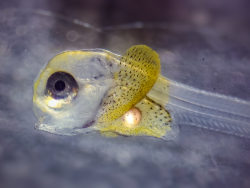For the first time, the Primorsky Aquarium’s biologists obtain offspring from a poorly studied predatory fish

Now tiny Agassiz’s snailfish (Liparis agassizii) are bearing a weak resemblance to adult members of the species: they have huge eyes and completely lack a characteristic sucking disk on the belly. The small snailfish are at most 5 mm long from the nose to the end of the tail, in some of them the yolk sac has not dissolved, and they cannot yet be called fry. But we can already say that biologists of the Primorsky Aquarium have become the first in Russia to gain a unique experience in captive breeding of this species.
Agassiz’s snailfish have been added to the Aquarium’s collection in the course of a marine biodiversity survey project in which staff members of the scientific and educational center participate. The fry measuring 1.5 -2 cm in length were caught in the wild and grown to sexual maturity in the Science and Acclimation Building. Adult snailfish are active and rather ravenous predators that is why in due time the maturing fish were switched from brine shrimp to frozen salmon and shrimp, and during feedings biologists simulated hunting situations – they lowered small pieces of food into the tank on special nylon clips.
“For our breeding program we chose two females and one male,” said Yuri Nekotinev, Specialist at the Department of the Russian Far East Marine Organisms. ”In the wild, Agassiz’s snailfish spawn in late December, under the ice, and we imitated mid-winter conditions by reducing temperatures to minimum acceptable levels. Two months after spawning, larvae began hatching from the light-yellow fish eggs.”
Though cosmopolitan and diverse (there are more than 400 species of snailfishes recorded in the world), the Liparidae is one of the poorly studied fish families.
”Snailfishes have neither scales, nor some other structures commonly used to identify fishes,” explained Dmitry Pitruk, Director’s Assistant in Biology. ”Colour pattern diversity within a species is another factor that makes classification difficult. For example, Agassiz’s snailfish come in a range of colours from brown to grey and almost black, and their coloration can be solid, striped, mottled or speckled.”
In fishes, scales serve a protective function; in scaleless snailfishes, this function is performed by their subdermal gelatinous layer. The same layer, from which members of this family get the common name of “snailfish”, maintains their buoyancy as they also lack a swim bladder.